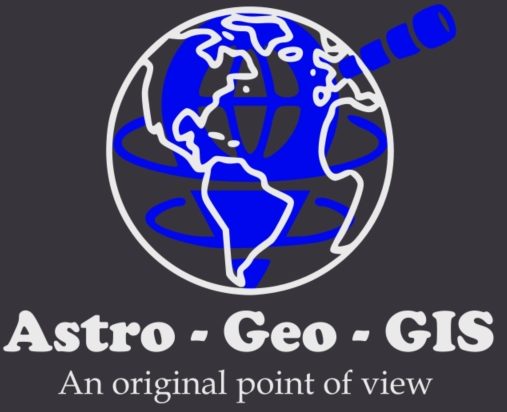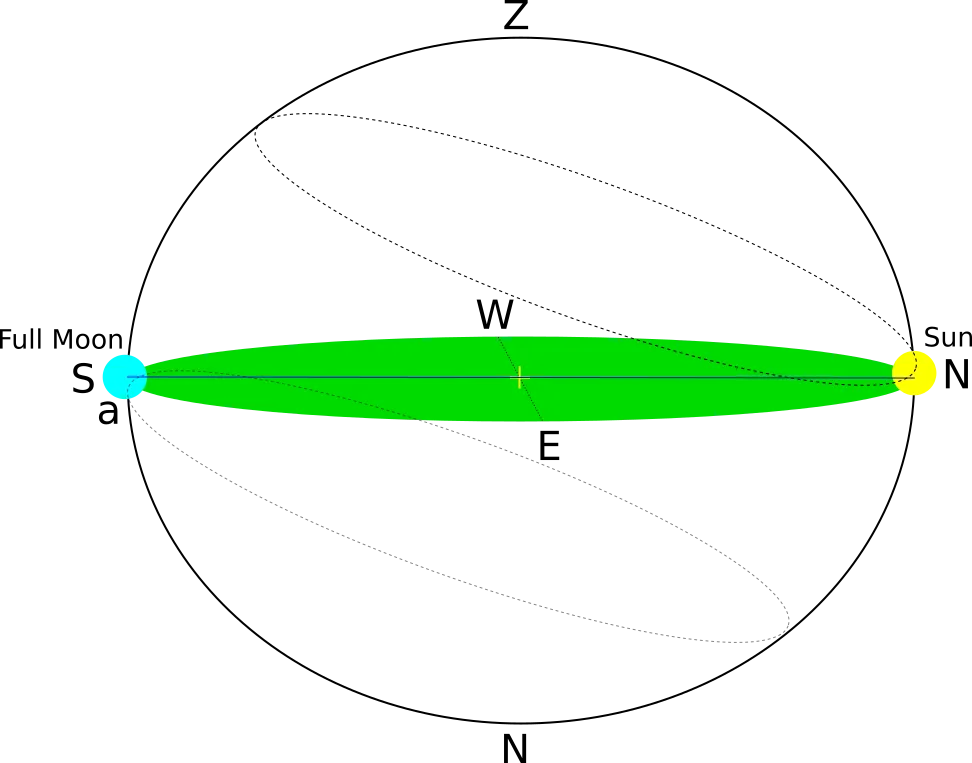At the beginning of this article, I would like to recall one of the questions, which appears from time to time on the Geography Olympiad. The query sounds like this: “If at 9 pm we have a Full Moon in London, what Moon phase can be observed in Pekin?” or something like this. The question, in fact, seems to be very easy at first glance. The first answer that would come to our mind would state, that since we have the full Moon in London already, due to parallax against Earth we should experience waxing gibbous in Pekin with something like 99.9% of illumination. The second understanding would lead us to a conclusion, that in both areas we can see the Full Moon because the Moon looks fully illuminated for a whole day therefore is considered the Full Moon from the point of view of the casual observer. To be honest both approaches have some bit of sense, although they aren’t right enough. That’s why in reality the question above it’s a quite tricky one, although hardly anyone is aware of it. Where the problem lies then?
Let’s consider the common understanding of the Full Moon occurrence. Both parallaxs take place and the Moon looks full for a while, but they don’t mean the correctness of the answer. The Full Moon phase is related directly to the alignment between the Earth and the Sun. That’s why the phase of the Full Moon is just a moment. In the previous article, I’ve explained what is the syzygy and brought you some information about the most perfect alignment possible. Now I would like to consider this alignment outside of the Earth’s shadow.
Because the Full Moon is just a brief moment, which applies to the Sun-Earth-Moon system, the answer to the question above is really simple. In both London and Pekin, we have the Full Moon occurrence. Another thing is the lunar parallax against the given location on the Earth. I will explain it more in further texts. For now, just worth mentioning, that the moment of the Full Moon doesn’t need to mean 100% visibility of the Moon.
The second question could be about the visibility of the Full Moon during the day in general. Most of the sources simplify the situation by explaining, that the Full Moon cannot be seen in the daytime, because it’s located on the opposite side of the Sun. Therefore it must rise at sunset and set at sunrise. In turn “we can’t see a Full Moon in the daytime” some sources say. My answer is different, because I know, that both Sun and Full Moon can be visible in the daytime!
The third question is finally related to the one set in the title of this text, namely, when can we see the Full Moon in daylight, and what conditions must be met?
The answer is twofold because we have atmospheric refraction, which influences the visibility of the Moon as roughly explained in the previous article.
Apart from atmospheric refraction, there is another factor, which determines the appearance (or not) of the Full Moon along with the shining Sun on the other side of the sky. This is the inclination of the lunar orbit, for which the mean value is about 5º08′ as discussed in one of the previous articles. In fact, we do not observe this size of inclination quite often, but in most cases, the lunar orbit is tilted against the Earth’s one. The exceptions are just eclipse seasons, where the Moon is aligned pretty much exactly with the Earth and the Sun. The lack of eclipse means, that the Moon, Earth, and the Sun are not in a straight line every day when the Full Moon occurs (Duggal, Burrett, 2010). Indeed, during this time the Moon can be above or below the plane of the Earth’s orbit. It surely results in its higher or lower position against the ecliptic. If this is so, the total time, in which the Full Moon can be observed above the horizon will vary from total daytime (from sunrise to sunset). And it does happen! Even if people are not really aware of it. Basically, since the Full Moon and the Sun can be visible both above the horizon, there are also situations, when both bodies are under the horizon. It’s driven exactly by the same factor – the lunar orbit inclination. In fact, the number of moments, in which both the Sun and Full Moon are below the horizon is reduced by atmospheric refraction, which gives an additional 35′ of visibility beyond the astronomical horizon from a certain location. Let’s see the example below (Pic. 1), where we can experience both the Full Moon and the Sun above the horizon as well as below the horizon.

At current circumstances of lunar orbit inclination, we can experience the Full Moon and Sun visibility in December and March, whereas in June and September both bodies are under the horizon at the moment of Full Moon occurrence (applies for the current year – 2022). Why does it look like this? The answer is based on the position of the ecliptic, which varies across the year. Near the summer solstice, the ecliptic is 23°27′ above the celestial horizon, on the contrary, a half year later its position is roughly 23°27′ beneath the celestial horizon (from the northern hemisphere perspective). When we watch the full Moon in December, when the Sun travels across the lowest position of the ecliptic, the Moon is on the opposite side, where the ecliptic runs the highest. On the other hand, the moment of the vernal or autumnal equinox is the best for checking the lunar orbit inclination against the eclipse season. The fact, that in 2022 Full Moon is observed along with the Sun in March is driven by the position of the lunar orbit nodes, which cross the ecliptic on May 16 and November 8. Obviously, we are sticking to the Full Moon only! It’s clearly understandable, that the Moon by revolving around the Earth and changing its phases keeps adjusting its inclination against the ecliptic every day.
The visibility of the Full Moon in March 2022 (and even in April) at sunrise means, that Moon is located in the northern ecliptic hemisphere, although its ecliptic latitude keeps reducing. On May 16th we had the total lunar eclipse, which occurred at the descending node. It was the moment when the Full Moon crossed the ecliptic to the other side and will remain in the southern ecliptic hemisphere until November 8. That’s why in September we might experience a Full Moonset far before sunrise and see neither the Sun nor the Full Moon visible for a while.
On the other hand, when we take into account i.e. 2013 when the lunar eclipse occurred on April 25th at the lunar ascending node, the situation was the opposite then. An observer was able to see the Full Moon at sunrise or sunset in September, but not in March 2013, when the Moon was in the southern ecliptic hemisphere. For a better understanding of how it works, see the images below (Pic. 2 – 3).

Concluding, We must remember an important thing, which is the nodal precession of the lunar orbit. This kind of precession determines the moments when the maximum inclination of the lunar orbit falls against the position of the ecliptic and when the eclipse seasons occur. Nodal precession determines the movement of the eclipse season across the ecliptic. Next, the eclipse season indicates when minor and major lunar standstill phenomena take place. These occurrences have been already discussed here and here. A major lunar standstill is in other words the correct position of lunar orbit nodes against the vernal equinox, which means, that the final equatorial latitude of the Moon is enlarged by its orbit inclination. A minor lunar standstill is an opposite event, which means, that the equatorial latitude of the Moon is suppressed and its value of orbit inclination reduces the absolute declination of the Moon.
If you still haven’t understood it until this point, I will provide you with an example of wave interference. The nodal precession of the lunar orbit creates something like wave interference, where both the ecliptic and Moon’s orbit inclination combine each other. In the case of a major lunar standstill, we have a classical example of constructive interference, which results in greater amplitude (in our case greater absolute declination of the Moon). On the other hand, the minor lunar standstill is an example of destructive interference, where both ecliptic declination and inclination of lunar orbit reduce each other. This situation occurs when both the maximum declination of the ecliptic and maximum ecliptic declination of lunar orbit inclination is 180º out of phase. Let’s see the depiction of our discussion below (Pic. 2).

Now let’s consider how it works across the year. It’s shown nicely in the images below (Pic. 5 – 7) which present the lunar position against the Sun across the whole year under major and minor lunar standstill conditions. Only the northern hemisphere is considered here, although for the southern hemisphere, you just need to treat these graphs upside down.


For the sake of clarification, we can see how it works. When in March, the Sun crosses the ecliptic at the vernal equinox, the Full Moon occurring at this moment will do the same in opposite direction at the other side. When we have the major or minor lunar standstill the situation will be the same because the vernal and autumnal equinox coincides with the eclipse seasons. In this case, when we are somewhere between the major and minor lunar standstill, both the vernal and autumnal equinox won’t mark the ecliptic crossing by the Moon. It will be determined by the “position” of the eclipse seasons marked by the placement of lunar nodes. The types of lunar nodes will determine on which ecliptic hemisphere an observer should expect the Full Moon at the vernal or autumnal equinox. Moreover, depending on the “distance” to the major or minor lunar standstill the ecliptic latitude of the Moon can vary from – 5,1º to + 5,1º. It does happen when eclipse seasons occur near solstices and the extremal lunar declination sort of overlaps the extremal solar declination. Returning to the beginning of my explanation, when at the vernal equinox the ecliptic latitude of the Full Moon is about + 5,1º (between minor and major lunar standstill), the ecliptic won’t be crossed yet, because our natural satellite still has that 5,1º to the ecliptic plane, therefore it should be visible along with the Sun in favorable conditions (sunrise/sunset). Conversely, it won’t happen in September, when the Sun goes beneath the celestial equator, because the ecliptic on the opposite side is upside down. Moon will be placed 5,1º beneath the ecliptic accordingly. It’s expressed perfectly in the images above (Pic. 1, 6, 7). When the lunar ascending node is between the vernal and autumnal equinox (between major and minor lunar standstill), the configuration will be opposite.
Finally, we are approaching the overall configurations typical for high latitudes, where in some parts of the year an observer is able to see the midnight Sun, circumpolar Full Moon, or unable to see neither Moon nor Sun. The range of visibility of these 2 celestial bodies at solstices is presented on the map below (Pic. 8).
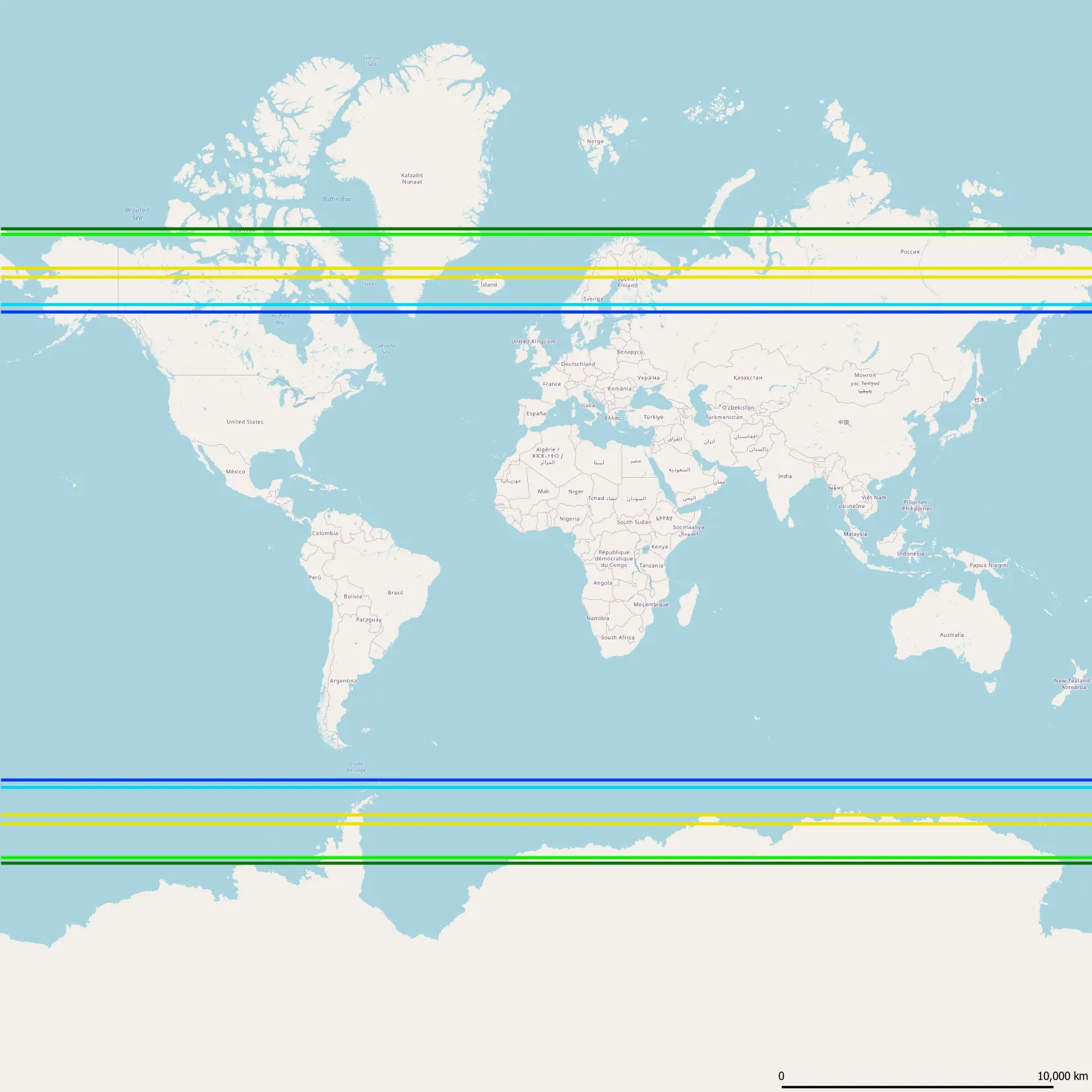
Below you can see the visibility configurations typical for specific situations (Pic. 9 – 14).
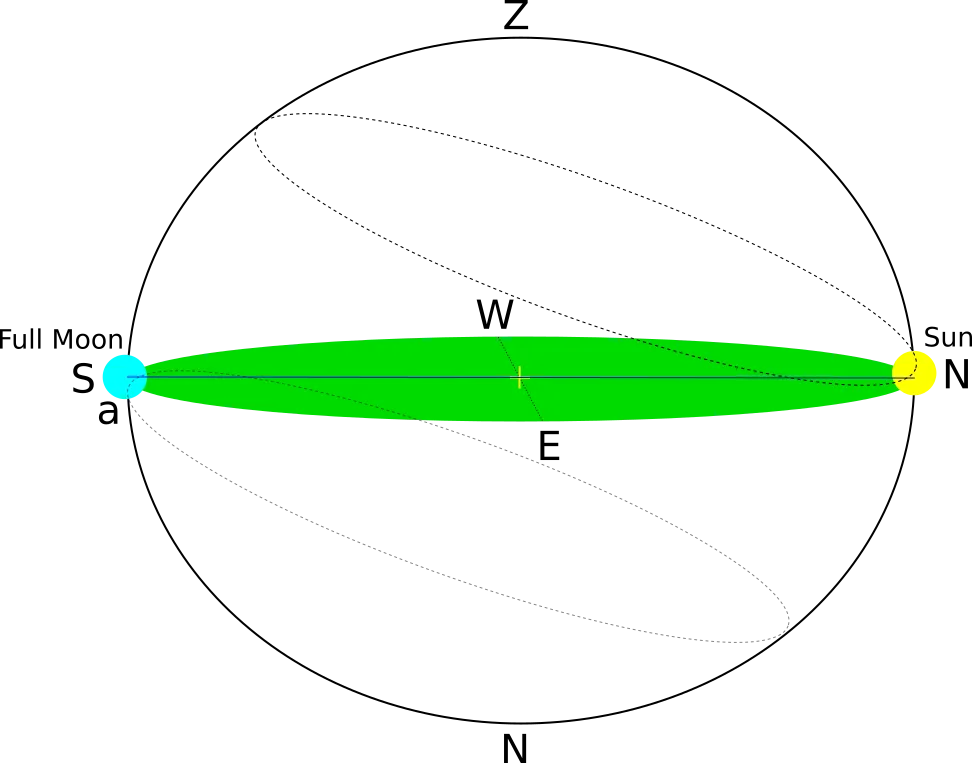
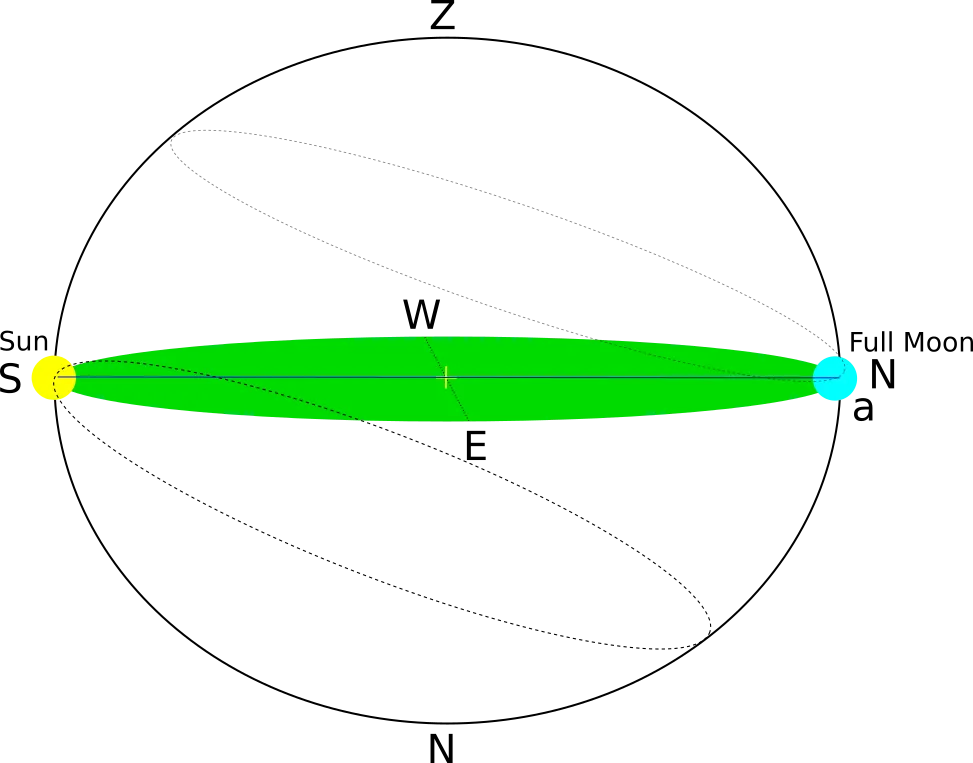
In the circumstances shown above (Pic. 9,10) the situation is straightforward because we have just mainly the influence of atmospheric refraction, which lifts up 2 bodies by 35′ above the astronomical horizon. Therefore both Full Moon and Sun can be observed simultaneously. In practice, alignment such as this happens close to the eclipse season.
When we have the major lunar standstill, the following patterns come into effect (Pic. 11, 12).
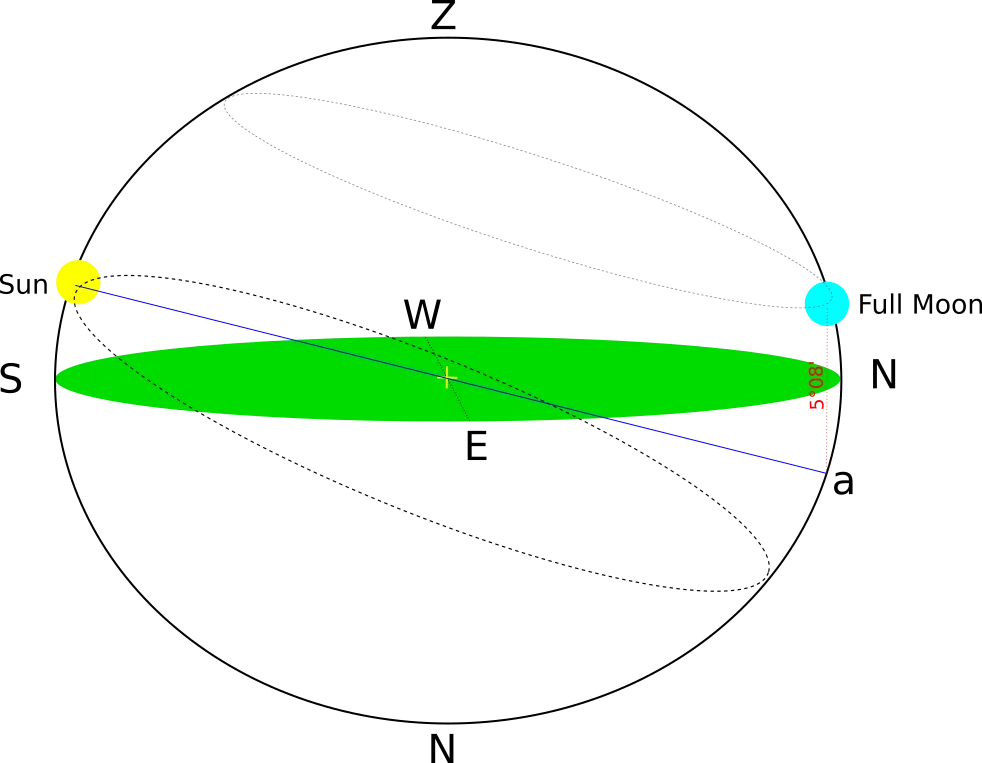
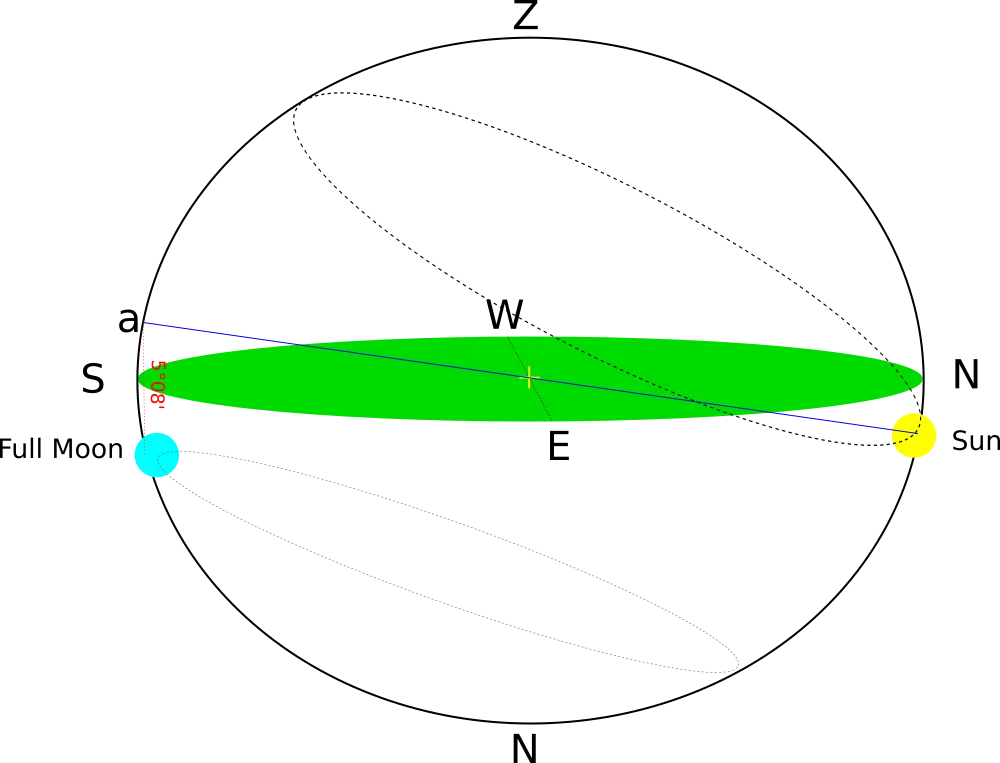
During the major lunar standstill, an observer located i.e. somewhere in central Scandinavia can see the Sun at noon and the Full Moon still above the northern horizon. This is because of the positive lunar orbit inclination against the ecliptic. Because December’s Full Moon position represents June’s position of the Sun + the positive inclination of the lunar orbit, our natural satellite remains visible all the time until its declination starts to decrease. In June, when an observer can experience a very bright night with solar depression lower than 5 degrees, the Full Moon cannot be observed. This is because the Full Moon’s position in June corresponds to the Sun’s position in December. When we increase December’s solar declination by the positive inclination of the lunar orbit, the Full Moon will pass the local meridian about 5,1º lower than the Sun does normally. Hence it will be invisible to an observer upon an increment of its declination.
The last considered configuration applies to the minor lunar standstill (Pic. 13, 14).
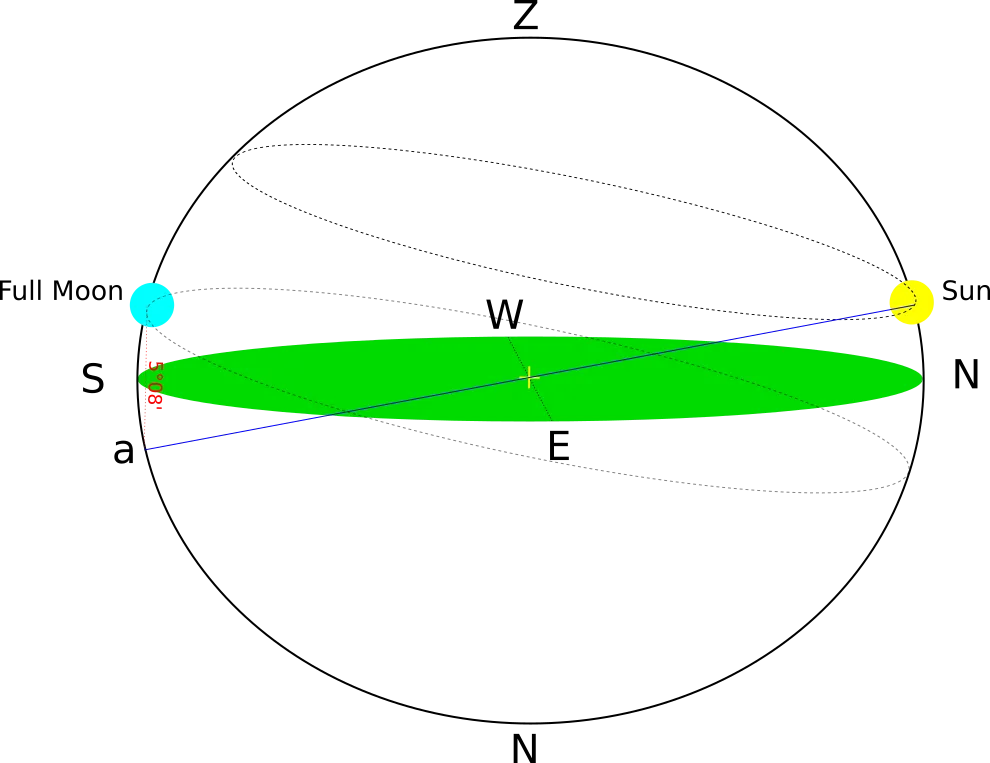
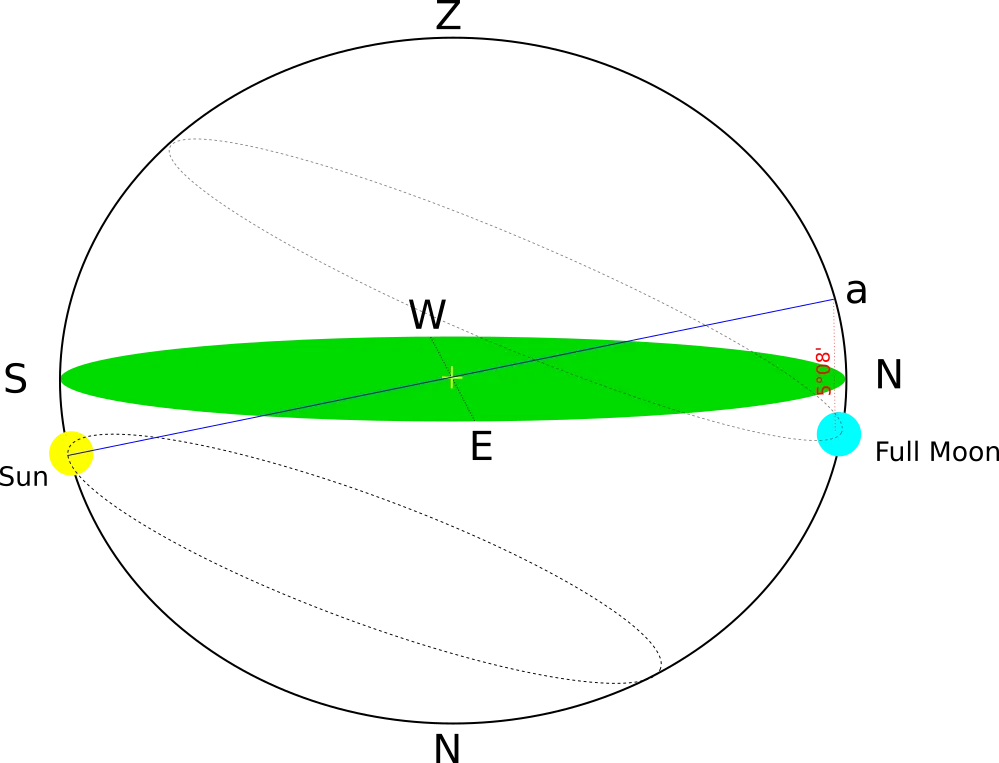
The minor lunar standstill period shows the mirror image of the major lunar standstill. By summer solstice, when the midnight Sun is observed inside of the north circumpolar region, an observer can still see the Full Moon unless the observation point is located further north than 5,1º from the edge of the circumpolar zone. Because the minor lunar standstill is a pure contradiction of the major lunar standstill, we have a situation, where the inclination of the lunar orbit is subtracted from the ecliptic declination. Therefore Moon never passes the local meridian lower than -23º27′ + 5º08′ in December. This reflection is perfectly expressed in June when the Full Moon’s culmination occurs 5º08′ higher than the solar one. At the winter solstice, the same location doesn’t provide the Sun and Full Moon visibility at all. The Sun passes the local meridian too low to be visible above the horizon. The Full Moon’s declination is not enough to make it visible for the entire day, though our natural satellite goes under the horizon for a while.
Let’s check it on some live examples provided by the Stellarium Web software (Pic. 15, 16). They apply to major and minor lunar standstills and show some geometrical approximations for our discussions above.


Concluding, the Full Moon is visible in the daytime much more often, than you think! We could even say, that a situation such as this happens every lunation somewhere on Earth. When an observer is unable to see the Full Moon in the daytime at the given moment, the other observer located in a different hemisphere can do it! In fact, we have considered only geometrical conditions. The atmospheric refraction helps too, but nothing can be competitive with unfavorable topography, which thread was discussed quite recently. Being placed in a rugged area, we often cannot see the Sun and Moon above the horizon, because the apparent horizon is usually higher than the astronomical one.
Mariusz Krukar
References:
- Duggal G., Burret P, 2010, Longman Geography ICSE 9, Dorling Kindersley, New Delhi.
Links:
- http://www.geoolympiad.org/
- https://earthsky.org/moon-phases/full-moon/
- https://www.timeanddate.com/astronomy/moon/full-moon-daytime.html
- https://www.fullmoon.info/en/blog/full-moon-daytime.html
- https://www.farmersalmanac.com/a-daytime-full-moon-17493
- https://earthsky.org/tonight/see-the-daytime-moon/
- https://hizen.from-va.com/can-we-see-full-moon-and-sun-together
- Rmg.co.uk: Full Moon calendar 2022
- https://www.heavens-above.com/moon.aspx
Forums:
- https://www.quora.com/How-can-we-see-a-full-moon-during-the-day-while-the-sun-is-still-in-the-sky
- https://www.physicsforums.com/threads/ever-seen-a-full-moon-in-the-daytime.47754/
Wiki:
